Sorgues In May 2016, as part of a VMS zodiac series, I posted a blog about Gemini symbols evolving from twin brothers to affectionate siblings to the “otherly” love usually associated with romantic couples. I noted that the Claricia Psalter is one of the earliest depictions of male/female Gemini in an affectionate embrace. If you haven’t read it already, I suggest you at least scan the second half of the previous blog.
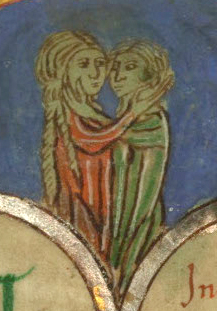 I chose the Claricia Psalter for a number of reasons—it is one of the first zodiacs to unambiguously show the twins as different genders, and is possibly one of the earliest zodiac images of “otherly” love (c. 1200s or earlier). It’s difficult to know if the figures are fraternal twins or a romantic couple, but the fact that they are male/female is a departure from classical images of Castor and Pollux, and also different from medieval images of the twins as warriors.
I chose the Claricia Psalter for a number of reasons—it is one of the first zodiacs to unambiguously show the twins as different genders, and is possibly one of the earliest zodiac images of “otherly” love (c. 1200s or earlier). It’s difficult to know if the figures are fraternal twins or a romantic couple, but the fact that they are male/female is a departure from classical images of Castor and Pollux, and also different from medieval images of the twins as warriors.
But there is more… it is also, in a sense, a “template” for zodiac cycles with the same cast of characters as the Voynich Manuscript.
Kurchaloy Background
I’ve already described classical zodiacs a few times, but here is one from the 9th century to make it easier to see the differences between this and later zodiacs that resemble the VMS zodiac. Note the girdle on Aries, the nude, male warrior twins, Cancer as a crab, a real scorpion, and Sagittarius as a centaur:
The Claricia Psalter (Walters W.26) was created about three centuries later, probably in the southern HRE about midway between Bohemia and the Alsace, and is distinctly different in a number of ways that are relevant to the VMS.
The Claricia Psalter was created for an Augsburg abbey (possibly commissioned) and yet is rather crudely drawn and painted, not much higher in general skill level than the VMS. The palette is also similar, although the Claricia is enhanced with some highlights in gold, and the shade of red is a little more orange than the VMS and used with more frequency.
Here is the Claricia zodiac together with the Augsburg Psalter (which is very similar in subject matter, and contained within roundels like the VMS):
Is There a Traceable Zodiacal Tradition?
Is it possible to pin down the VMS to a specific illustrative tradition?
When I search through my database of more than 500 medieval zodiacs, I find fewer than 40 (only 6% of the total) that have this particular combination:
- male/female Gemini,
- Libra scales with no associated human-like figure, and
- Cancer as a crayfish/lobster.
What is even more significant about this combination-search is that quite a number of the hits also have a non-scorpion Scorpius (in the form of a turtle/tarasque, dragon, or reptile/amphibian)—another commonality with the VMS—as in this example from the 13th century, created a few decades after the Claricia Psalter. Note also that the zodiacs are contained within roundels, like the Augsburg Psalter and the VMS:
To push the comparison with the VMS beyond the realm of coincidence, some of them also have Sagittarius with legs and Leo with his tail threaded through his legs.
I can’t quite tell if Cod. Vindo. Pal. 1982 (14th century) is male and female or two males, but it otherwise fits in this group, with a no-hand Libra, Cancer-crayfish, human Sagittarius, and tarasque-Scorpius.
Even though it is roughly drawn, and colored only with a bit of amber wash, the zodiac symbols in BAV Pal.lat.1369 (c. 1400s) have much in common with this tradition, as well. The couple is male/female, Cancer is a crayfish, and the scales have no figure. But this is a scientific compilation with many charts, and a number of volvelles, and the illustrator drew the zodiacs with the traditional centaur and a more-or-less real scorpion.
Note the clothing, which is very similar to the VMS, including unembellished round necklines. The symbols are contained within roundels and the labels are in German, but German was used in many places, including eastern Switzerland, Germany, parts of Bohemia, and parts of Lombardy, so the language doesn’t specifically pin down the localality:
This combination is first seen around the 1100s or 1200s and continues until the early 1500s. If we eliminate Sagittarius as a centaur, then we are left with those originating around the time of the Claricia Psalter until the 1470s. Specifying a human Sagittarius eliminates Hildegard von Bingen’s zodiac, a 13th-century zodiac from Stuttgart, Ludwig VIII 3, Codex Sang. 42, and the Augsburg Psalter, but I was curious to see which ones had the greatest similarity to the VMS symbols.
Morgan MS M.280 is very similar in format to Walters W.78 (the Augsburg Psalter). It has roundels with a clasping couple, crayfish, no-figure scale, and tarasque-Scorpius, but lacks the human Sagittarius:
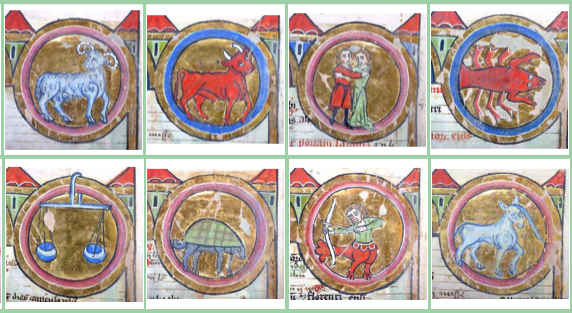 Morgan M.280 and Walters W.78 demonstrate how two different illustrators can draw essentially the same things in quite different ways simply by changing the direction of a head or tail, or adding a detail or two:
Morgan M.280 and Walters W.78 demonstrate how two different illustrators can draw essentially the same things in quite different ways simply by changing the direction of a head or tail, or adding a detail or two:
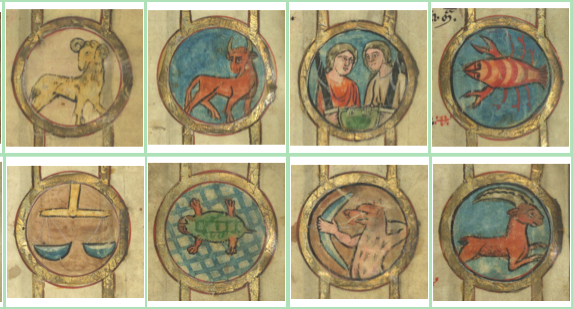 Even though it has twists of its own, like the double-crayfish and the added stars, in terms of subject matter and chronology, the VMS zodiac fits quite well with this group. You can almost guess that Aquarius would probably be a mostly-clothed male with a single jug rather than two, and that Capricorn would be a running or walking goat rather than a mythical goatfish or a goat next to a water-well:
Even though it has twists of its own, like the double-crayfish and the added stars, in terms of subject matter and chronology, the VMS zodiac fits quite well with this group. You can almost guess that Aquarius would probably be a mostly-clothed male with a single jug rather than two, and that Capricorn would be a running or walking goat rather than a mythical goatfish or a goat next to a water-well:
Another Transition
By the 1460s, another change was unfolding… a number of zodiac illustrators who closely followed the above patterns, including leg-tail tongue-Leo, reverted back to the traditional nude male twins and naturalistic scorpion, as in Codex Pal. Germ 298 (which also has a crossbowman) and LJS 449.
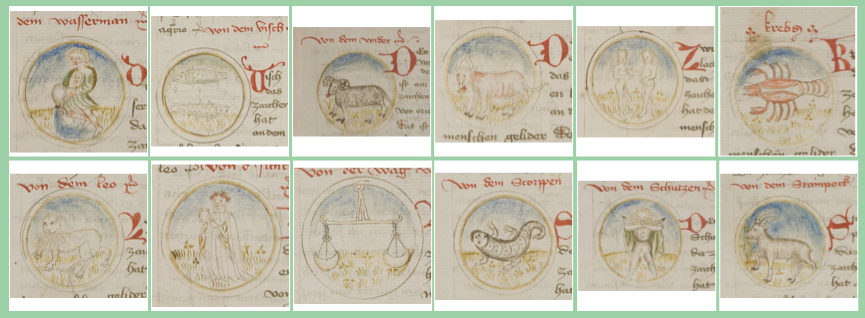
Dating to approximately the mid-15th century, Codex Pal. germ 298 includes roundels with crayfish-Cancer, leg-tail Leo, no-figure Libra, and the famous crossbowman, in keeping with zodiacs already mentioned, but like LJS 449, Gemini has been drawn as traditional nude twins rather than as a romantic couple in fine clothing.
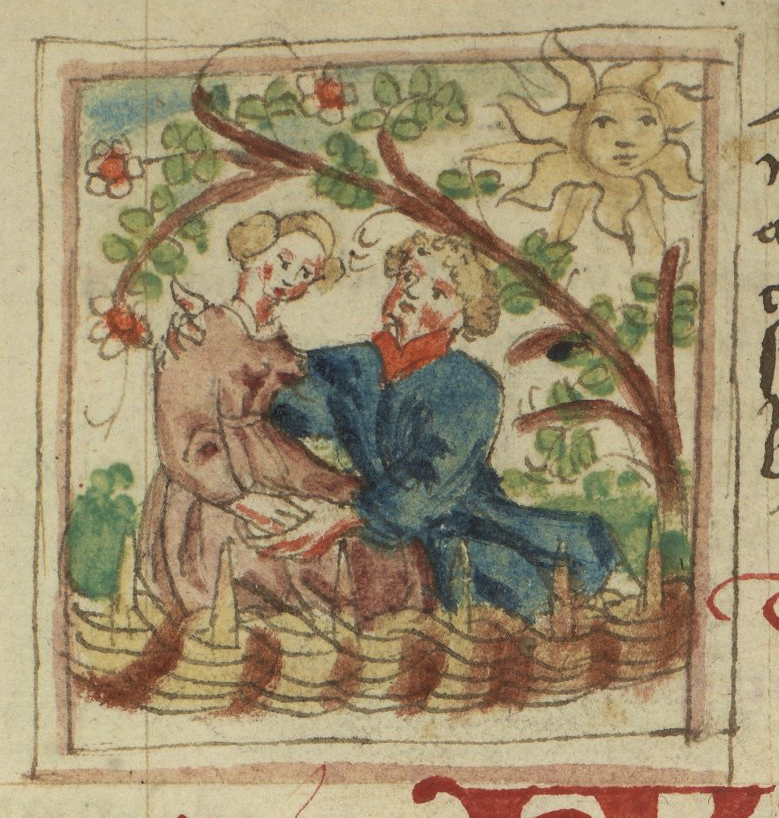 But wait… LJS 449 has two zodiac sets (the second one incomplete) and in the second (which is the signs associated with their ruling planets), the symbols are contained within roundels, and Sagittarius is a human. Separate from the zodiacs, under a tree in a garden, we see an amorous couple. LJS 449 also has some medical topics, including an illustration of urine specimens.
But wait… LJS 449 has two zodiac sets (the second one incomplete) and in the second (which is the signs associated with their ruling planets), the symbols are contained within roundels, and Sagittarius is a human. Separate from the zodiacs, under a tree in a garden, we see an amorous couple. LJS 449 also has some medical topics, including an illustration of urine specimens.
Ludwig XII 8 also seems to fit within this group, with no-figure Libra, crayfish-Cancer, romantic-looking Gemini, a slightly dragony Scorpius, and a human archer. BSB CGM 7269 is similar, as well, and includes a crossbowman. The twins are of both sexes, holding hands, and sharing a bath (the “in” thing to do at the time was to dine together while bathing).
Cod. VIndo. Pal. 1951 (c. mid-1400s from France?) converts the bowman back into a satyr. Morgan MS G.1 (c. 1450s) has a lizardly Scorpius but Sagittarius is a centaur, and the twins are youthful nudes. It seems that by the later-1400s, some illustrators were reverting to traditional forms (as in Vat. Barb.lat.487 and Walters W.428), with the exception of Cancer, which remained a crayfish into the 16th century.
Summary
Can we geolocate the closest matches?
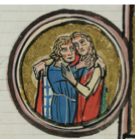 Even though the non-scorpion Scorpius may have originated in NE France, the manuscripts that combine it with male/female affectionate Gemini and crayfish-Cancer seem to be mostly from southern Germany, especially around Augsburg, with one from Basel, Switzerland (14th century).
Even though the non-scorpion Scorpius may have originated in NE France, the manuscripts that combine it with male/female affectionate Gemini and crayfish-Cancer seem to be mostly from southern Germany, especially around Augsburg, with one from Basel, Switzerland (14th century).
This survey is restricted, of course, to digitized examples available on the Web, there may be treasures hiding in dusty libraries, but at least it gives a reasonably good picture of a specific approach to zodiacs that is consistent with the VMS.
J.K. Petersen
© Copyright 2018, All Rights Reserved

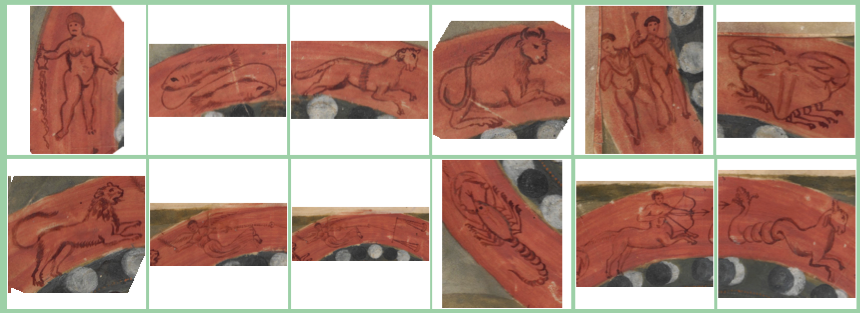
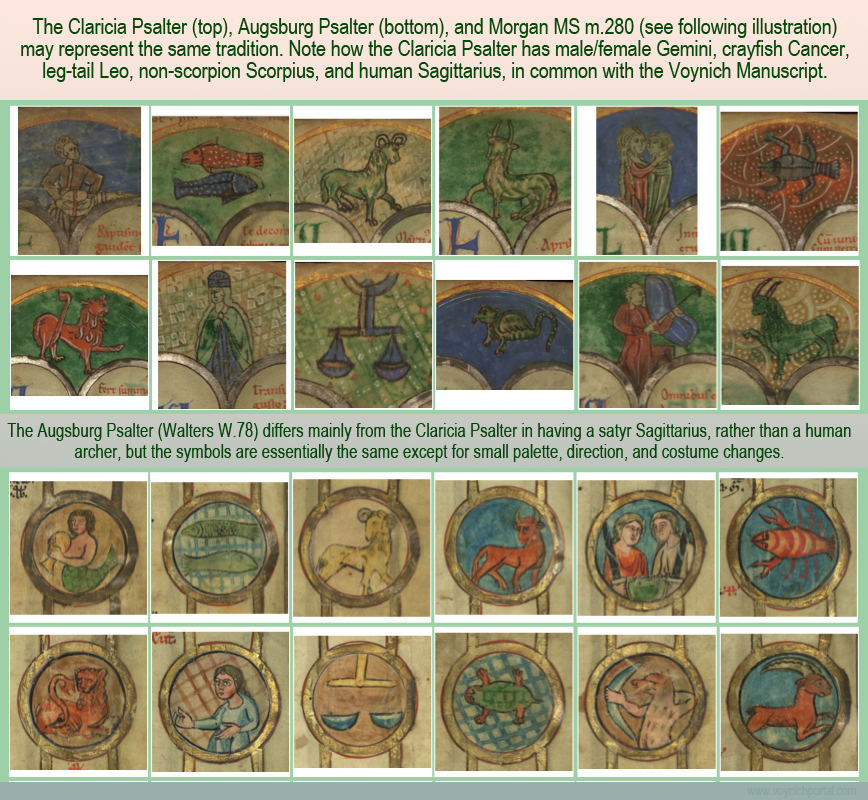
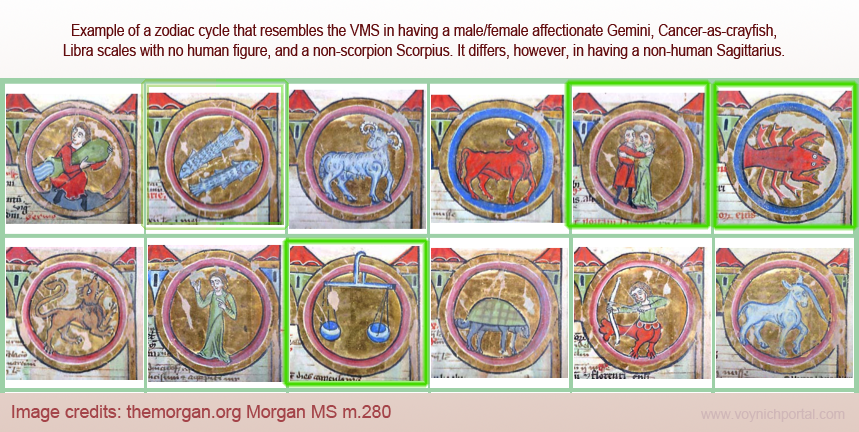
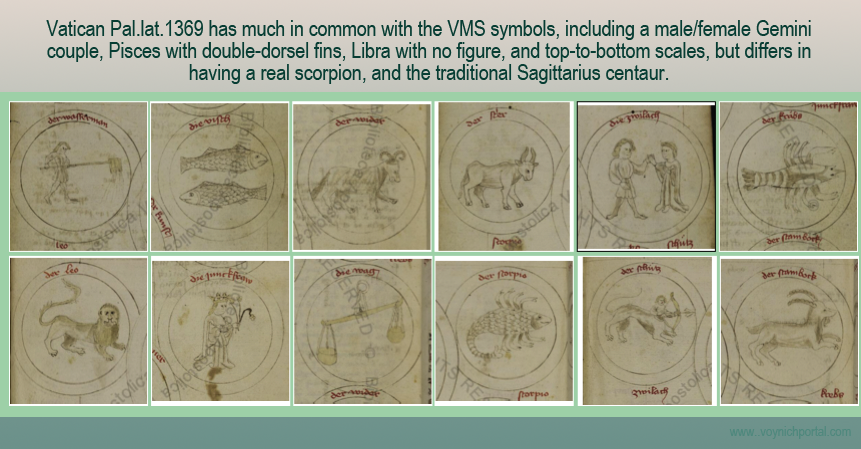
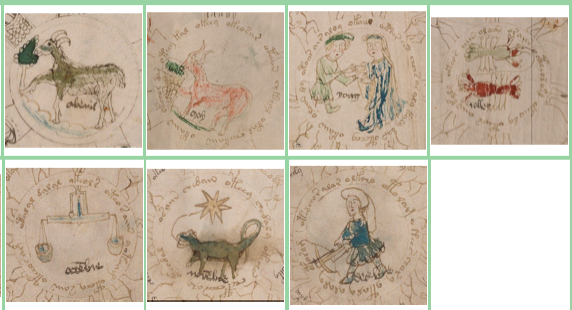
Great stuff. I had a thought about the zodiac emblems, what if each came from a different place, ie they picked out the most anomalous from each group they saw. Then maybe each zodiac page is a different place? Just a thought. I actually think they are different times.